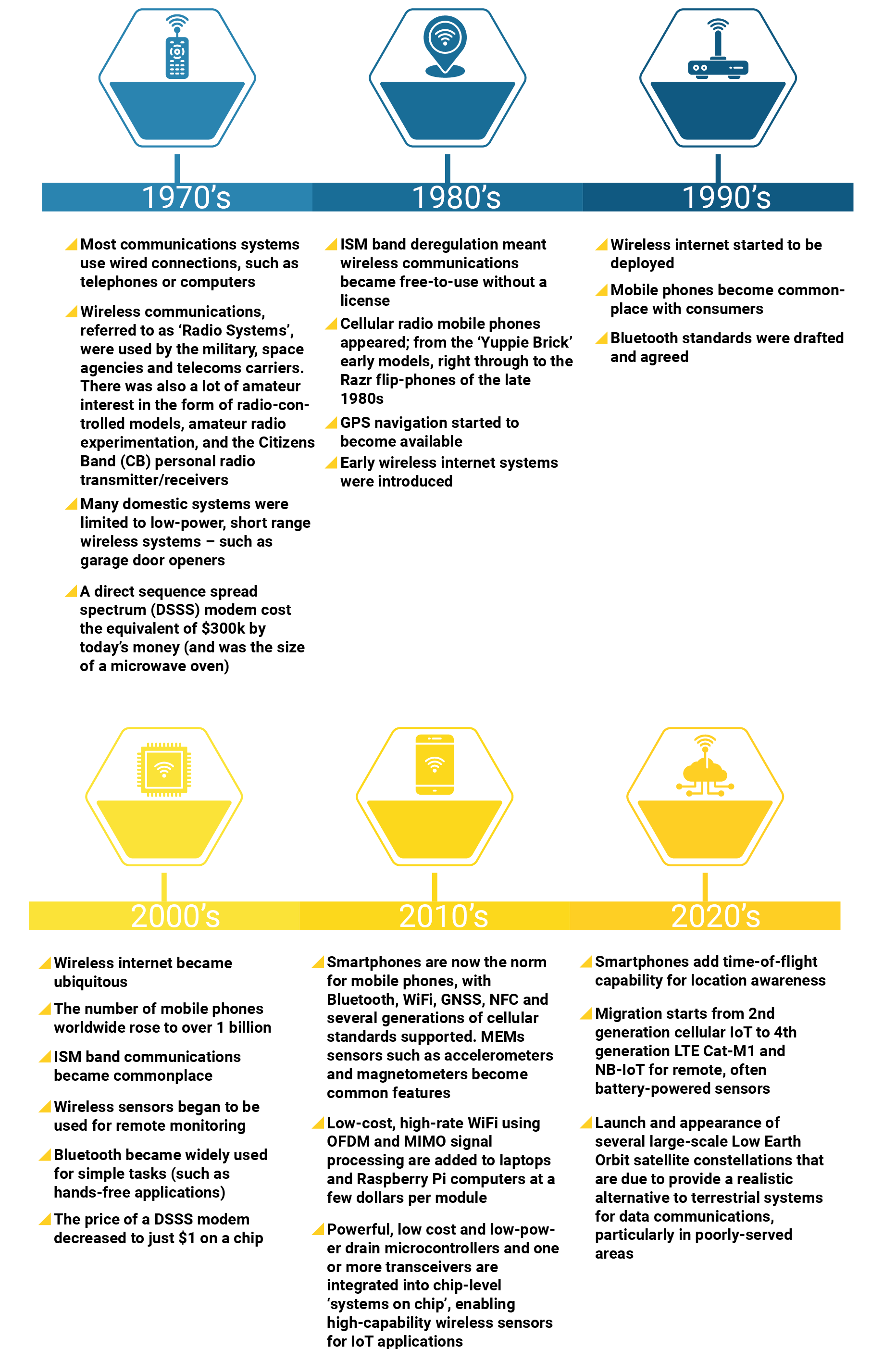
Wireless communication trends to shape your business
Wirelessly-enabled devices continue to be developed due to demand from consumers (for convenience) and businesses (for cost-cutting and process improvements).
To help you understand how innovations in wireless technology can help your business gain a market advantage, this article explains the progress that has already been made, takes you through current trends and tips for making the most of them, and shares our thoughts on the future direction of the technology.
You can learn more about our capabilities in wireless communication by contacting one of our technical specialists.
Where have we come from?
Every decade since the 1970s has seen significant evolution in wireless communications. Here are some key milestones:

What is trending in wireless technology?
This section identifies both upward and static trends that can shape the future of your business, along with tips for making the most of them.
Upward Trends
Miniaturisation
This is a key driving force that makes wireless technology more usable, practical and feature-rich. By the rate of miniaturisation over the last 45 years, a component on a chip measuring 10um (micrometres) in 1970, would be just 5nm (nanometres) now, a reduction of 4 million times in area. This trend has enabled the remarkable rise of the smartphone and also very low-cost, high-performance chips for use in IoT.
Interconnectivity
The remote connections and control of things are a clear trend today. The use of the web, cloud-based systems and connected devices (commonly called the ‘Internet of Things’) is now often helped by ‘edge’ hubs and computing to provide local computing and communications. This reduces the costs and energy of data transmission, which is becoming increasingly popular and is a trend that will continue for the foreseeable future.

Affordability
As we can see by the 1/3 of a million decrease in the cost of a DSSS modem over the past 40 years, technology gets significantly cheaper over time. Further reductions in component, system and manufacturing costs will drive forward the implementation of new technologies.
Quick tip – Consider how the falling cost of key components could open up new possibilities in the near future and design solutions that take full advantage of these opportunities.
Device convergence
Smartphones are a perfect example of how many different functions can be brought together in one system. Users are keener than ever to control different technologies from a single point that is convenient to them and easy to use. As such, you need to ensure that your wireless device or system communicates well with the popular native wireless standards employed in the growing mobile market.
More than that, wireless devices increasingly need to use several types of wireless communication within the same design e.g., WiFi as well as Bluetooth. This prolongs the useable life of the device as it can communicate with a variety of network types and settings, widening its market appeal.
Quick tip – Do your homework when selecting a wireless device, especially when choosing ones that include several communication standards. Ensure your needs are well-matched by the features the standards offer.
Device performance
Sending very large amounts of data quickly over a short range is becoming increasingly possible and, more importantly, economic as well. The wireless market is already seeing the emergence of high speed 60 GHz radio frequency devices capable of 10Gb/s data rates.
Whilst systems using such frequencies were previously an expensive and not very widespread option, the device costs continue to drop. This has enabled wireless networks and devices to increase performance thresholds further. 5G cellular networks are driving the consumer use of these higher frequency bands.
Quick tip – Be clear about what data you need to communicate, how far and how frequently. This is the basis for deciding which technology provides the best solution. Have a big vision of what you want the technology to achieve and ask a wireless expert what solution will best meet your budget.
Static Trends
Battery energy density
Battery energy density has increased just threefold in the past 40 years, a tiny amount compared to the miniaturisation of integrated circuits. The focus for miniaturising equipment or extending battery life has to be on reducing energy consumption, particularly maximising the time equipment is ‘asleep’.
Quick tip – Choose a battery with the greatest capacity within the physical size constraints of your design.

Radio range
Radio range for typical applications such as remote control and monitoring has not markedly increased during the evolution of wireless networks, as enlarging transmission range requires more power and is expensive to implement. Another factor limiting this is the regulatory limits on transmitter strength.
Consumers are now used to accessing widely available local access points or cell towers and do not necessarily expect long-range communication from their devices. Some techniques are used for long-range wireless devices in smart monitoring systems, however they require a very low data rate.
Quick tip – Increasing radio range comes with compromises in other areas of the system design. The best route is to work within the performance constraints of common communication methods.
Where is wireless technology heading?
Increased performance in wearable devices and processing power
Battery-powered, wearable wireless devices will increase in capability and performance. This will influence the design and use of the technology in all applications. The wearable device market is predicted to jump from $14 billion in 2014 to over $74 billion in 2026 (source: IDTechEx).
Lower radio component costs
The growing trend of embedding radio components in systems on a chip (SoC) offers new opportunities to use a wireless connection in designs that previously didn’t have the feature. Complex systems will be more cost-effective and easier to integrate into designs.
Greater sensor variety and use in wireless systems
New ways to collect data and automate systems will be available as it becomes more cost-effective to implement wireless systems. The ability to deploy such sensing systems more easily will result in increased targeting of niche monitoring environments. Sensing systems simultaneously measuring multiple sources of diverse data will be common.
Even smaller device sizes
Further functionality will be introduced into smaller-sized applications. For example, wireless devices and systems will increasingly be used in medical treatment and intervention. Devices capable of using several different types of wireless connections will be common.
Higher bit rates
Wireless systems utilising higher bit rates will increasingly become available. These faster wireless connections allow more data to be transmitted over a given time, but come at the expense of radio range.
Increased device interconnection
Devices are increasingly being designed to collaborate and connect with other wireless systems and the internet. Interconnected devices increase the potential to integrate various systems and control them from one place. Tens of billions of internet-enabled smart devices with IP addresses are estimated to be connected to the internet by 2025 (source: IDTechEx).
Keep in mind
- Significant improvements in transmit power, sensitivity and range are not expected. Wireless communication systems are already near the regulatory and fundamental limits in each of these areas.
- Significant improvements in battery capacity are not expected. Battery life will remain static while improvements to efficiency are made to keep up with increased demand for higher performance.
How can your business make these trends count?
Wireless communication is a fast-moving sector, both in terms of technology and user adoption and expectations. The growth of the last few decades has accelerated with the mainstream arrival of wireless internet usage and the Internet of Things.
Several key trends, such as miniaturisation, interconnectivity, affordability, device convergence and increasing performance should be leveraged to help shape the future of your business, whilst working within the constraints of radio range and battery life. The certainty is that wireless communications systems will need to become even more complex to evolve and grow – ensure that your organisation gets the right advice and expertise to make sure you’re ahead of the game.
To learn more about IoT and Edge Computing Solutions, contact a Captec technical specialist today.



